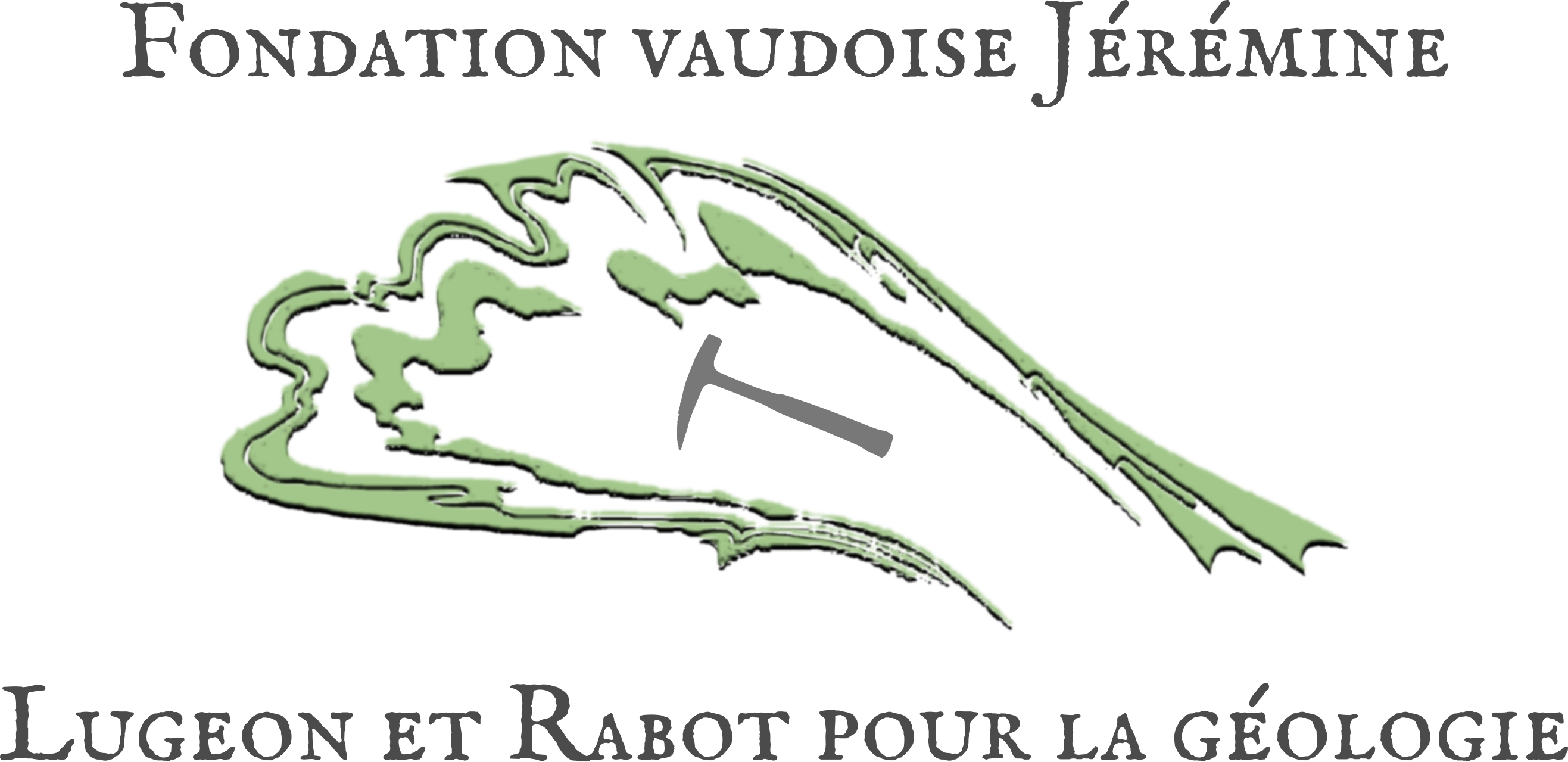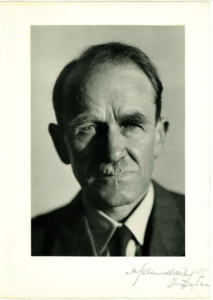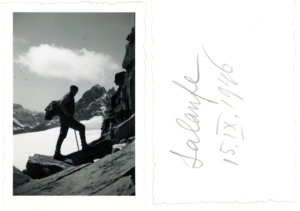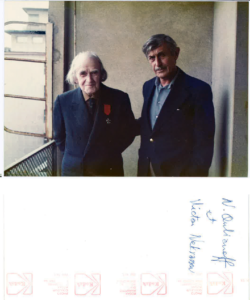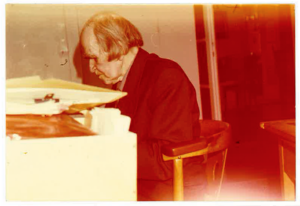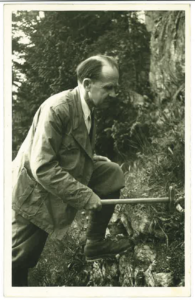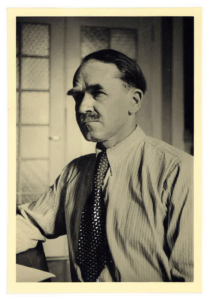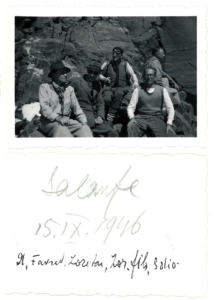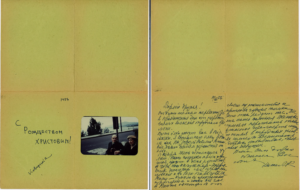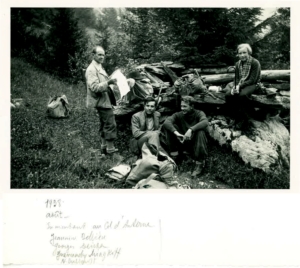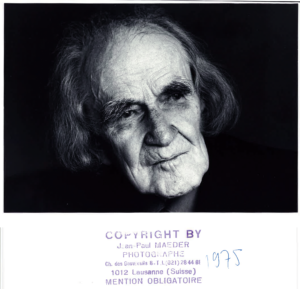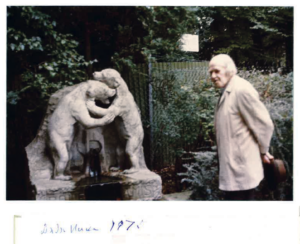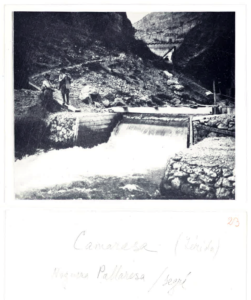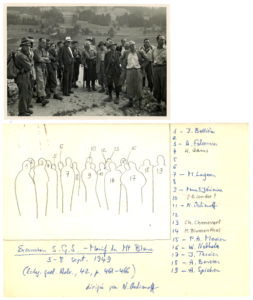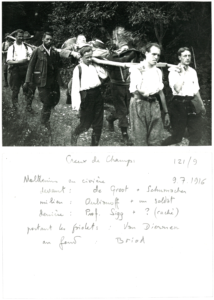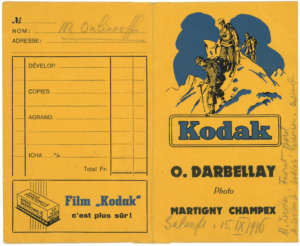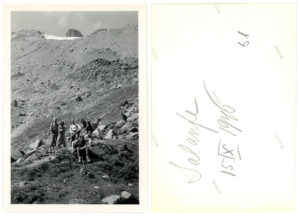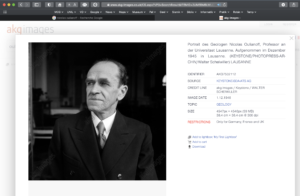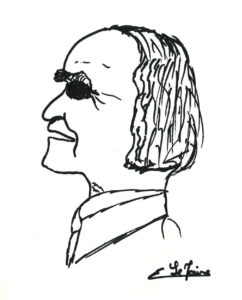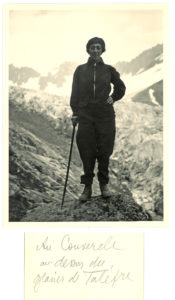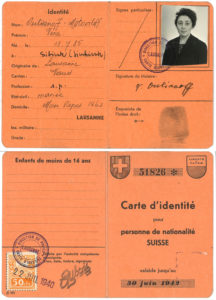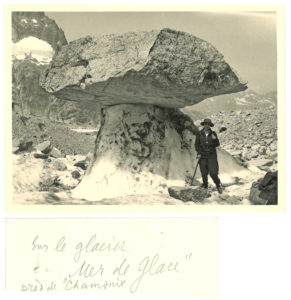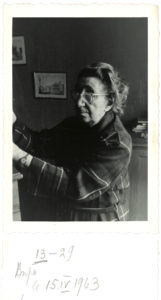My two lives
When we started our geology studies, in 1949, the holder of the chair, Elie Gagnebin, had just died. The courses were given by three people, including Nicolas Oulianoff, professor of geophysics. The following year, Professor Héli Badoux was appointed director of the Institute of Geology.

Oulianoff was then 68 years old and we kept him as a professor of geophysics for another two years. Besides geophysics, he taught us how to make a topographic map with simple means, what was called exploration topography. During an excursion to La Fouly in 1951, he was 70 years old, still working and still a good walker: he accompanied us twice to the A Neuve glacier to measure the ice flow.

He had developed a special compass named after him, with which it was possible to draw a map. He even taught us how to draw a map from photographs. Our admiration for him meant that we continued to see him in retirement and, as part of our diploma work, equipped with a pegbox, the Oulianoff compass and a Leica, we drew a very presentable map of the Plaine Morte glacier. Stephen Ayrton, professor of petrography, recorded N. Oulianoff's memories. A complete paper version can be consulted at the Geological Museum. Nicolas Gex, historian, has worked on this material and transcribed the events of interest to a historian in a very well documented work1 . However, Ulyanoff's memoirs contain many anecdotes which, in our opinion, justify a full transcription, at least in their first part. Many publications have been devoted to the centenary of the 1917 revolution, and we thought it would be interesting to show how a young man of modest means, gifted and courageous, had lived through this event and the years that preceded and followed it. These memories are rich in numerous incisions, returns to the past or, on the contrary, projections into the future that make it difficult to read. This is why we have allowed ourselves a chronological reordering for this adaptation, which makes it easier to read. And we have chosen to illustrate these memories by reproducing some engravings published in 1880 in Universal Geography of Elisée Reclus, because these images are beautiful and because they give an idea of the environment that Ulianoff knew in his youth.
Marcel Burri and Arthur Escher
1. From Nijni-Novgorod to the shores of Lake Geneva: Nicolas Oulianoff, a journey from politics to geology. Proceedings of the June 2011 colloquium: Two centuries of Russian presence in the Pays de Vaud.. Slatkine 2012.
I was born on December 15, 1881 in Petersburg. But I would like to say a few words about the revolutionary youth of the 1860s to 1880s. I was told a lot about all this, especially my father who knew well, personally, some of the most important personalities of these movements. And I myself, later on, also met some of them.
The administration did not know what to do with the more than one thousand people who had been imprisoned for subversive activities. Often it was exile. There were also large trials of a political nature, but this often backfired because the revolutionaries found it a very interesting platform to express their convictions. It must be said that the judicial administration was remarkably independent, following the reform of Alexander II. Judges were appointed for life, and the political power, which severely feared some of them, could not dislodge them. Thus, the accused were able to express themselves very freely.

The man who was to become my father was a schoolteacher. Even before he passed his baccalaureate, he had decided to go to the countryside to teach the peasants to read and write. At the first opportunity he settled in a village near Petersburg. There he met my future mother, also a teacher. Both of them, like most young people of that time, were strongly influenced by the revolutionary currents of the time, especially by the philosophy of the "Land and Freedom" movement, and both of them saw teaching and information as the best way to put their political ideas into action. There is perhaps a connection with Tolstoy.
Some memories go back to then. My grandfather, for example, who adored me. I was his only grandson, and he used to feed me candy on our walks. I got sick from it and other health problems followed throughout my first year. It was my mother who saved me by opposing the indications and decisions of the doctors who treated me during that period.
My parents were involved in the underground revolutionary movement and, like many others, were spotted by the police and imprisoned. At that time, in Russia, cases of a political nature were generally judged by the administration (political police, gendarmerie corps). My father was sentenced to four years of deportation to Eastern Siberia. My mother and I, their sick son, were allowed to accompany him on the deportation convoy. We had to pass through the Moscow prison before undertaking the long march, on foot or on horseback (the Trans-Siberian Railway did not exist yet!) beyond the Urals. In view of my condition, a famous professor of medicine examined me in prison and declared that I was not likely to survive the journey, but my mother's care prevailed and we arrived in Tomsk, Siberia, in late 1882.

Tomsk was the stage. All deportees had to stop there. In the local prison, they were examined by a doctor. The one who examined me probably had rather liberal political views. In his report to the government, he mentioned, among the deportees, the presence of a small kid who was seriously ill and unable to go to Takutsk. So we settled in Tomsk, with the permission of the governor, in principle for the duration of my recovery. In fact, the administration soon forgot about us.
The family grew with the birth of two more boys and a little girl who was unfortunately taken away by illness at a young age.
Tomsk was a very interesting city. There were many famous deportees and people of high culture there, among them Prince Alexander Kropotkin, brother of Peter Kropotkin. The former, an astronomer, had worked at the observatory in Pulkovo, near Petersburg, before being deported, while the latter, one of the leaders of the anarchist movement, began by traveling, fascinated as he was by geography, and especially in Siberia where revolutionary movements were fermenting. Soon the police spotted Pierre Kropotkin's subversive activity and arrested and imprisoned him, but thanks to friends he managed to escape to London where the Royal Geographic Society received him as a friend. It should be said that Kropotkin had sent the results of his research on Altai to the Royal Geographic Society and that he enjoyed an excellent scientific reputation. In London, he could continue his work while working for the realization of his anarchist ideas. Since he could not go to Russia, he occasionally sent his daughter, whom I knew well, to Tver, where the family of his uncle Alexander later settled. In Tomsk I was often with the Kropotkin children, and later I met them again in Tver, where we formed a small band led by "niania" of the Kropotkin family. I remember our house in Tomsk, next to our friends' house, and our common yard, which was sometimes penetrated by ice fragments during the spring breakup of the Tom River. And then there were quite a few other deported revolutionaries, especially people from the south, Georgians, Armenians, Azerbaijanis.
During this time, my father found a job in Saratov on the Volga River, in the railroad, but soon after, friends in Tver told him that they had found a more interesting place for him and so we moved there and I lived there until I was ten years old. (1891)

My father was the secretary of the justice of the peace in Tver, a nice man named Karnioukov. My mother, who could not work as a teacher as a former deportee, founded a small school for the community of political friends. There were the Kropotkin, the Ragozinev, myself and others. Father Ragozinev, a great entrepreneur, was involved in the oil export business, which at that time started in Baku, where the famous Nobel was also working.
Every summer, Karnioukov invited my family to his country estate "Karmenka", about fifteen kilometers from Tver, a three to four hour walk. Friends would come and join us, and at the table of the day ("soumeski") we would sing in chorus, led by my mother's beautiful voice. My father encouraged me to take care of a botanical garden with a wide variety of species. I found great pleasure in walking through the forests and fields because he knew nature well. He had started to write small stories that were much appreciated by publishers, as well as poems for children. Every year, for the feast of Saint Nicholas 1 my father would give me a poem about nature or about the life of peasants. It must be said that this general interest in natural sciences characterized the intellectual atmosphere of Russian youth in the second half of the 19th century.
In Tver there was a real colony of revolutionaries who had in common not only their ideas, but also a black Newfoundland dog called "Negro" who came scratching at the door. We would open the door and he would come in, eat, spend a few days with one of us, then go to another, and so on.
Of course, the authorities were suspicious of this small circle of former deportees, and all the suspects were on the black lists of the gendarmerie (the special political police force created by Tsar Nicholas II), but since they were unable to detect any subversive activity (organization of a secret typography, meetings of peasants, workers, etc. ....), they did not intervene.
_______________________________________________________________________________________
1 St. Nicholas, the only one to be celebrated twice a year. My parents chose this name in honor of my grandfather, and registered me in the baptism book for the feast on the 9th of May, the month of nature's awakening. It should be added that the baptism was obligatory and I had to undergo this celebration in spite of the reluctance of my parents, a severe control being applied by the clergy and the police. Moreover, all the students of the secondary school had to confess once a year to the priest of their educational institution.
_______________________________________________________________________________________
Some members of the community later became leaders of the revolutionary movement, especially women. Women played a leading role in the revolutionary movements and in the evolution of ideas. There was no "female" problem, no problem of equality between the sexes, this being absolutely admitted by all revolutionaries, while the University, for example, was closed to women and this until the revolution of 1917. However, there was a private university for women, founded at great expense by Bestovjev-Rumine (the same man who built the Rumine Palace in Lausanne) in Petersburg. A complete university, except for medicine and theology taught at the Theological Academy, which was completely separate from the University. The courses at Bestovjev-Rumine were held in his own house where he had installed some modest laboratories, the teaching was of the same level as that of the University. Of course, a considerable number of women went abroad to receive a university education, especially in medicine, and particularly in the Swiss universities of Lausanne, Zurich and Basel. There they had many contacts with Russian political refugees of the left and extreme left. They returned to practice their art after passing an exam in Russia and spread the revolutionary message, especially among the rural population.
The same message penetrated by other ways too, of course. Thus the magazine "Kolokol", which means "The Bell" (symbolizing the tocsin, the alarm) edited by Herzen, who had left Russia on the eve of the revolution of 1848, regularly ended up on the table of the Tsar, without him knowing by which way the newspaper (which did not spare him!) penetrated his palace.
But let's go back to Tver where my father worked for the justice of the peace. In 1890 he received a letter from Korolenko,2 who was already a famous Russian writer, very active in humanitarian movements and who had been deported to Irkutsk. Korolenko was located in Nizhny Novgorod, at the confluence of the Oka and Volga rivers, and on the railroad line to Moscow. It was a trading town with large mills.

Besides the club of nobles, who were only interested in card games, there was another special institution, the "Vsesolovny" (club of all classes of the population), which was open to everyone. There was a library open to everyone. When the librarian left, Korolenko thought that my father, with whom he had corresponded through mutual friends, could take the position. So my father left for Nizhny Novgorod and some time later the rest of the family followed him. There we met Korolenko and the Annensky brothers, one of whom was a journalist, sentenced to "light" deportation to Nizhny Novgorod, and the other, a poet, was a teacher at the gymnasium in Tsarskoye-Solo. Both of them contributed to a large monthly magazine "Russian Wealth" and wrote the general column (avoiding the term "political") under the name Oba. There were also two daily newspapers in Nizhny Novgorod, one more commercial, the other more general.
____________________________________________________________________________________
2 Vladimir Korolenko (1853 - 1921) deported to Siberia from 1879 to 1884 was a disciple of Jean-Jacques Rousseau. He was the author of several novels, the first of which earned him his sentence.
____________________________________________________________________________________
Sketches and small stories of my father appeared in this newspaper from time to time. Finally the editor offered my father a permanent position. The editor was also a deportee, and the whole group was a very close-knit community. So my father left the library, leaving behind important traces of his activity.
Korolenko actively looked after the former deportees by finding them work, for example, on the ships carrying travelers on the Volga. He was a great help to a young writer named Alexis Piechkov, who became Maxim Gorky, who was first hired as a secretary in a merchant's house before he became famous. I remember that my father brought him books to read.
During this time, my mother was preparing me for the high school entrance exam because I was 10 years old. The school board felt that I could start directly in the second grade. My schoolmates were often playmates, like Korolenko's two daughters, the children of his sister the Lochkarevs, the children of our landlord, an architect named Lenke. Korolenko had encouraged us to publish a collection of our "works". It was in 1892, the year of the great famine in Russia. Entire villages were decimated. Korolenko took part in an action of mutual aid to the peasantry, an action that was opposed by the authorities who did not want to make noise about this calamity, and by the Church who said that this plague represented a deserved punishment for our sins. This was the official thesis. To this was opposed that of the "intelligentia".3 The group was a Russian organization that tried to help the starving in spite of police surveillance and arrests. Our small group participated in this action under the impulse of Korolenko and we sold a number of our collections, and donated the money to the aid movement.
At school everything was going well. The education I had received from my parents was a great advantage. From the first year we learned German, and from the third year French, always with native teachers, but it was still rather bookish. It was not like the Smolny Institute, founded by Catherine II for the education of young girls, where the pupils had to speak French all day, then German the next day, English the day after, and so on. My aunt, a student of this Institute, ended up being a translator. It was at school that I had my first contact with Switzerland, because the French teacher was a Raymond from Lausanne. He used to tell us about life in Switzerland, its geography, the mountains. This fascinated us because we didn't really know what a mountain range was. When I was 16 years old my mother took me and my brothers to the Urals and I saw the mountain peaks rising above the clouds. It was overwhelming. And four years later I saw the Alps for the first time.
Through Gorky, the "Samarskaia Gazeta", of socialist, even Marxist tendency, offered my father an even more interesting position and so the family (in 1896?) left for Samara, except for me, because I was in my last year of school. I spent this year in the family of a doctor, head of the hospital, and then I joined my family in Samara.
I was 17 years old and faced the problem of what to do next. Physics attracted me enormously. I had read a lot and even undertaken small experiments. Finally I decided to prepare for the entrance exams to three of the big technological institutes in Petersburg. The city had many universities, to which thousands of candidates applied every year in autumn. Fortunately, I had an excellent mathematics teacher who trained all the students in the class to prove theorems by themselves. I was satisfied with what I had learned and took the entrance exams of the Institute of Technology, which included physics, mathematics and Russian language. There were 2'000 candidates for 200 places and I was admitted.
In Petersburg I lived with my grandmother from 1898. Soon I had an interview with the professor of physics Gesekus, where I expressed my interest in magnetism, and in particular in the effect of magnetization on a body. It seemed to me that one could show a variation in length related to this effect, and I started to work in the laboratory on this effect. But a few weeks later Gezekus told me that a Japanese had just published a paper that said exactly that, and I had to give another direction to my research.
____________________________________________________________________________________
3 This Russian term is borrowed from the French and is widely used nowadays; for Russians, however, it evokes those who have the ability to understand things without necessarily having a great deal of knowledge, whereas in French it contains the notion of culture.
____________________________________________________________________________________
Arrived at Christmas I went back to my family in Samara. January 6 (1899?), the day before the beginning of the university year, was an academic, unofficial, even semi-clandestine celebration. Fifty or sixty people would gather at the home of a private individual, a doctor, a lawyer, often of liberal conviction. I attended one of these meetings where there was a professor of Russian history, a contributor to the magazine Russkoe bogatsovo ("Russian Wealth") directed by Korolenko. It was cheerful! We were telling stories and singing a lot, when suddenly a student came and said: "Bad news: the tsar has issued a decree to Finland that greatly limits its freedom". This decree was contrary to the agreement signed between Finland and Alexander II and the reaction was not long in coming. The next day, January 7, the students occupied the auditoriums and proclaimed a general strike despite the police controls at the entrance of the Institute. Only a few lectures by professors loyal to the regime were held. The famous mathematician Markoff, for example, gave his for several days in a row, before an empty audience.
A committee decided to organize a demonstration on Nevsky Propekt: it ended tragically with the Cossacks on horseback assaulting the crowd, using their special leather whips "nagaika" containing pieces of iron. I witnessed all this and was so moved that I went to the editorial office of "Russkoe Bogatsovo" to see Korolenko, Annensky and Mihaeovsky, philosopher and critic, and told them what had happened. They were scandalized and decided to react by publishing, distributing and posting leaflets, as newspapers were subject to censorship. I was in charge of printing leaflets thanks to a collaborator of the Ethnographic Museum who had access to a mimograph and to a family friend, a former examining magistrate, disgusted with the tsarist justice. We worked in a suburb, and I left with lots of leaflets hidden under my clothes. Similar meetings took place all over Russia, with strikes and demonstrations in all the higher schools.
The police didn't waste any time either, and on my way home one night, my landlord handed me a paper that the police had left for me. They demanded that I go to their office and sign a commitment to attend classes, under penalty of expulsion. I didn't go and the police came the next day with the order to expel me from Petersburg. So I left Petersburg with a large number of comrades (a small minority had agreed to return to classes), and I found myself in Samara, a first and brief page of my student life over. My parents' welcome was warm. They were proud of my conduct, which was perfectly compatible with the ideology of the Russian "intelligentia".
I was forbidden to continue my studies in Russia, and this was very painful, but the situation was even worse for those who were close to finishing their studies. I had to find work and I applied to the "Zemstvo", a governmental (=departmental) administrative body in which representatives of the population, mainly landowners, participated. It was especially concerned with economic problems: trade, agriculture, transport routes and public primary institutions, but here, although it was responsible for building schools, it could not appoint teachers. This was a matter for the central government, because it was feared that the "Zemstvo" would include people like Bakunin, a landowner but an anarchist.
In particular, the "Zemstvo" had to analyze the factors governing the state of the agricultural economy, and for this purpose, statistical offices were created. People with scientific education were hired for this purpose. Almost all of these employees belonged to the "intelligentia", because this work, which was very poorly paid, attracted idealists who saw it as an excellent way to get in touch with the people. I presented myself to the local "Zemstvo". They needed an investigator whose job would be to go to the villages to examine and take soil samples, which would then be analyzed in specialized laboratories. It is under the impulse of professor Dokuchaev of the Agricultural Academy near Moscow, father of pedology, that, towards the end of the XIX century one introduced the physical and chemical study of soils, leading to a classification according to their composition, their origin, biological qualities, etc... This work in close collaboration with the "Zemstvo" led to methods of improvement of soils 4 .
I had to visit one after the other all the villages around Samara. When I arrived in a village I had to contact the chief (''starosta''), inform him about my work, and ask him to organize a meeting with the most educated and capable inhabitants, whom I interviewed about the conditions of agricultural work in their village. There was a printed questionnaire for the whole Samara district. The meeting where the answers were written down lasted two, three or even four days. Then we went to the field to collect samples, the location of which was plotted on a map or on cadastral plans, with a morphological description of the place in question.
____________________________________________________________________________________
4 Soil science was then developed in Western Europe, especially in Germany and in France where a pupil of Dokoitchaev, Agafonoff, continued this research.
____________________________________________________________________________________
I first went to the region of Bougourouslan, where Slavic ethnic groups, the Cheremeiss, lived, sometimes in isolated villages, but more and more integrated into the Slavic wave as a result of economic exchanges. It is in this mixed environment that I began my work, and on horseback, because that is how people moved around in these regions. But without saddle and sometimes on a stallion full of spirit! Back in the village, I asked questions, completed the questionnaire, and then went to the next village.

On one of my returns to Samara, I met Catherine Brechko-Brechkovski, who was warmly received by my mother. This woman, the daughter of a landowner and wife of a state official, was a great revolutionary who had left everything to join the underground struggle. She was arrested and sentenced to hard labor in Siberia. After a few years, she managed to escape with the help of accomplices, she followed the trail through the taiga, getting closer to the Sea of Okhotsk, reaching Japan with the help of smugglers and, finally, London where they tried to hold her. However, she was anxious to return to Russia to renew contact with revolutionary circles, especially students. She went from one house to another to spread the revolutionary message, in secret of course, because she was known and wanted. When she arrived at our house (she knew my mother only by hearsay, but she knew that she would find a friend in her), Brezhkovskaya organized a meeting for students to tell them about what she had experienced.
At that time we lived on the second floor of a house belonging to a monastery, where the first floor was occupied by nuns. The monastery was located 60-70 km from Samara, in the middle of the countryside; the nuns and the abbess used this apartment as a pied-à-terre when they came to collect money in town. One nun always stayed there to take care of the housework and prepare for the arrival of the others. This nun, Vassilissa, who lived on the first floor with two or three young nuns, came to visit us after we moved in. She was surprised not to find any icons. Soon after, one of the nuns was injured, so she came to ask my mother for help, and a relationship was established. Vassilissa (whom we called "Vassiona"), intrigued, finally asked my mother why there were no icons in our house, and if we were not believers. My mother answered that if we were believers it was not in the strictly ecclesiastical sense, that we did not go to church, but that we had our ideals for which many people had suffered, even perished. Afterwards, my mother hung up the icon with which my grandfather gave his blessing at my parents' wedding, so that anyone who wished to do so could make a religious gesture when entering our home. Vassiona came more and more frequently to our house, under any pretext, to talk with my mother, and of course, all this spread. Other nuns came to listen to my mother, and even a very wealthy businesswoman from Samara who had retired to the convent (which lived on donations and bequests from landowners). She had learned about our convictions and appreciated them.
So Brezhkovskaya was at home. One evening, returning from the statistical office, two policemen in front of our front door. I immediately thought that it was related to the great revolutionary. They let me in. I found my mother, a gendarmerie officer and some other policemen. Here is the revolutionary student," said the officer. "Fortunately, we did not find any revolutionary literature, only poems by Nekrassov. Finally he signed a report, my mother and I signed it too, and the policemen left.
My mother was finally able to show the strong emotion she had been feeling for two or three hours, and told me that when the police arrived she had thought it was for Breshkovskaia, and that she had hidden her in her bed, under a heap of blankets, with her head buried under a pillow. She told the police that it was a poor old woman sent by the nuns who could not take her in. They searched the whole apartment without bothering about Breshkovskaia!
My mother had another adventure like this one. At the same time (1899), Guerchouni, founder of the organization of the armed struggle, affiliated with the socialist-revolutionary party, was arrested and sentenced to prison in Siberia, especially for his participation in attacks against the tsar. The prison was supplied from outside. The convicts, under escort, brought barrels filled with salted cabbage for the preparation of cabbage soup, a very common food. Guerchouni had hidden in one of these barrels that were returned to the cabbage supplier. Everything had been ingeniously prepared in advance, in particular the horses thanks to which Guerchouni was able to cross the taiga and reach Japan. From there he went to London, from where he wrote a letter to his friends, in which he described his escape in terms that inflamed the revolutionary youth. He also addressed the great problems of the time. The letter of Guerchouni was multicopied and distributed clandestinely. A copy reached Samara where revolutionaries and sympathizers were gathered to read it, pretending that it was a family party, with cakes, jams, etc. My mother was there. And then the doorbell rang. A gendarme started asking questions of those present and threatening to take some suspects of revolutionary activities to the station. Suddenly, my mother, who had seized Guerchouni's letter and was holding it in her hand, said: "But, officer, since you are here with us on the occasion of this party, why don't you take a glass of tea, I'll prepare it for you. She opened the teapot and at a favourable moment dropped the letter into it, covering it with tea leaves and hot water. Then she serves a glass to the officer who leaves with a suspect, a former deportee.
These meetings played an important role in the preparation of the revolution, and it was obviously not without risks. They were everywhere, and they brought together people from very different backgrounds and professions. In addition to these, there were terrorist acts for which people like Vera Figner5 Hermann Lopatine and Nicholas Morosov6 among others, were sentenced to long sentences. The 1905 uprising brought about a temporary amnesty, thanks to which many prisoners, like these, who were locked up in the Schliesseburg fortress, were released. Vera Figner (and Lopatine as well) became a great friend of my parents. At the same time, censorship was lifted, and there was an explosion of publications of all kinds, which were soon suppressed by the repression.
But I anticipate. Let us return to Samara. At the beginning of 1900 I received a letter from the Petersburg Institute of Technology stating that I could continue my studies after passing an examination. I hurriedly went back to Petersburg with a friend who was a student of the Institute of Roads and Bridges. We took a room together and the following months were devoted to private lessons that we gave to gymnasium students during the day to survive, and at night to study in three-hour shifts, one working and the other sleeping, and then the reverse. And we were both received. In the summer I returned to the "Zamstro" in Samara where I resumed my horseback riding (and without stirrups! I became a strong rider).
At the beginning of August, I returned to Petersburg to resume my studies. Christmas arrived and I spent the holidays with my family. On June 3, 1901 I was back in Petersburg and on June 6 the general strike was declared in all university cities of Russia. It had been learned that some students, judged particularly dangerous and sentenced to deportation to the north of Russia or to Siberia, had not been amnestied and the indignation was at its peak. This time I was advised to study abroad. I decided to go to the Polytechnic in Munich and went there without delay.
____________________________________________________________________________________
5 Vera Figner 1852 - 1922 was a member of the "People's Will" committee. She took part in the organization of attacks against Alexander II and was sentenced to death in l884, sentence commuted to life imprisonment and deported to Siberia, she returned to Russia in 1915. Another revolutionary who participated in the assassination of Alexander II, Sophie Perovski, daughter of the governor general in Central Asia, was executed.
6 A remarkable scientist, Morosov worked a lot in prison, especially in the fields of physics, mathematics, astronomy and geology. He wrote a volume devoted to the scientific explanation of the apocalypse, published just after his release.
____________________________________________________________________________________
Then began a new chapter of my life, with, first of all, the learning of German, which I had learned a little at school. I went straight into the second year of school leading to a degree in mechanical engineering. Apart from my studies, I spent a lot of time in the large Russian colony in Munich. Many people were there to study at the University or at the famous Conservatory of Music. And the atmosphere in the colony was one of revolution. Every two or three weeks there was a public lecture, in Russian, to hear an experienced revolutionary like Rabushinsky, Breshkovskaya, etc. I also went to concerts, especially those conducted by the famous Weingartner.
At Easter a colleague suggested that I go on a trip to Venice with two other friends. I was very tempted, but I didn't have the money. In the end I decided to go anyway because I wanted to see the Alps at all costs. It was agreed that we would only spend the bare minimum. So we left, first by train to Partenkirchen, then on foot over the Seefeld pass, the first real mountain pass I had the joy of crossing in my life, the first of many! Then over Toblach to the Ampezzo Pass. And there, it's a snow storm. What to do? There is a lull and we leave, the snow above the knee. We take turns to open the track. The chance is with us: a coffee is on our way and we settle down there to drink a glass of ''Glühwein'', then we leave again towards Cortina where we arrive in the evening by a beautiful sunset, but quite soaked. Our means do not allow us to stay in a hotel, so we continue our way, freezing, with frozen clothes. Beyond the customs, exhausted, we finally find a welcoming house where a lady allows us to lie down for the night without accepting a penny. And we go down to find down in the valley the spring! The trees are in bloom, we eat in a café, and it is the road until Treviso then Maestre where we hear songs and mandolins, (and I think of Goethe!).

The next day we are in Venice and directly in Piazza San Marco. For three days we wander the city in all directions, amazed. From there we left for Verona, my friend Gourvitch and I on foot, then we went to the Lago di Garda and then to Limone, a small village stuck in the mountains. With Gourvitch we returned on foot through Merano, a station for tuberculosis patients, and the passes that we had crossed on the way to Munich, where the Russian colony welcomed us, admiring the sporting feat, an average of 50 km of walking per day.
We went back to study while following the revolutionary movement. Trotsky came to Munich several times to give semi-clandestine lectures without too many problems because the Prince-Regent of Bavaria was quite liberal. And then I went to the concert. Weingartner had a full house, and I remember a very remarkable opera conductor who conducted behind a folding screen: he felt that the audience came to listen to the music and not to watch the conductor. The screen was removed at the end of the performance so that he could greet the audience.
I entered the second year and took mathematics, physics, technical drawing and spent many hours in the remarkable Munich library, among others for Jean-Jacques Rousseau, in French, of course. Encouraged by a certain Zhukovsky, a relative of the founder of aeronautics, I passed through Geneva before returning to Samara on vacation, with the aim of taking delivery of a double-bottomed suitcase filled with clandestine literature printed on very thin paper used by smokers. I took the opportunity to go to Evian and the Rhone valley, on foot to Montreux, with a boat trip around the lake. First contact with Switzerland. From Munich I went again to Dresden to admire the wonderful painting of Raphael, Our Lady, which made a great impression on me. I loved painting and I had already explored the Italian, French and Flemish treasures of the Hermitage. Among them were the beautiful Rembrandts that Catherine II loved so much.
The border was very tightly controlled for a very specific reason. From the end of the 70's many young girls wanted to go to Switzerland, France, Germany, especially to study medicine. They needed their parents' consent, and if they could not get it, they found another way. In Petersburg, at student meetings, they looked for a companion who was willing to marry (blank) and whose signature was sufficient to carry out their project. They were, of course, animated by a great revolutionary fervor. Many of these marriages lasted. But this trick did not escape the attention of the Tsar's police, who increased their surveillance. A rather funny story happened to Borodin, the great composer, chemist and professor at the Military Medical Academy. He was leaving for abroad with his wife. Long stop at the border. The customs are searching everywhere. Mrs. Borodin went to the buffet of the station and Borodin remained alone in his compartment. The customs officers accompanied by gendarmes arrived. Borodin presents his passport. One of the customs officers looks at him attentively and asks: "Where is your wife?" "She went to the Buffet, to take a coffee". What is her name? Her first name?'' "I can't remember,'' says Borodin. Ah, it is serious, Sir, very serious. At this moment Mrs. Borodin returns and her husband to shout quite naturally '' Machenka, Machenka what is your name?'' One did not insist.
In short, the border had long been guarded. However, there was so much traffic that it was impossible to control everyone, and that's how we managed to get our double-bottomed suitcases filled with clandestine literature across.
In 1901 I had to interrupt my studies again, my family being unable to support me financially. So I returned to Samara. At that time the shipping companies on the Volga and Oka rivers were happy to hire those who had returned from deportation. In Nizhny Novgorod there was a company called "Nadezhda", whose director was a Tchaikovsky, brother of the composer and friend of Figner. The inspector of the company, a former deportee named Sagine, had married Vera Figner's sister. That's how I became an assistant inspector of this company.

So I left for Nizhny Novgorod where I brought my mother and brothers. In Semstovo my mother found a job. We soon came into contact with the revolutionary and progressive circles that were beginning to organize themselves into cells. I remember an anecdotal incident that tells us a lot about the atmosphere of that time in the region. I had been sent by the Nizhny Novgorod regional revolutionary organization to a meeting of cells in the Murom region. A gendarme got on the train where many peasants had settled. He soon intervened in our discussions about agricultural prices, but soon began to talk about the problems of Russian society. According to him, the revolutionary rioters only want to create disorder, and they must be suppressed, as well as the Jews, who are largely responsible for these disturbances. And then, he continued, the police are watching, because the Russians cannot be allowed too much freedom, because they are stupid, they don't know how to defend themselves, how to organize themselves. All of a sudden, under the blow of an inspiration, I get up suddenly and hit my fist hard on the wooded wall and shout: "How, dog that you are, how dare you say that the Russians are stupid? That's how the police rule the people and instill in them the idea that they are stupid. How can you say that? You, who are a gendarme and who, on the contrary, must look after the heritage in Russia. You deserve to go to jail. I'm going to report you at the next stop. I can't allow such a thing. This is a scandal! The train slowed down and the gendarme got out of the car at full speed and ran away under the laughter of the peasants, all of whom agreed with my words.
On another occasion I was almost caught by the gendarmes during a meeting of some fifty people in the psychiatric hospital in Tver. It was thanks to a phone call, following a warning from a sympathetic gendarme, that we were able to escape. But the gendarmes knew about the meeting from a member of our organization. So if there was sympathy on their side, there were traitors on ours. Sometimes it ended very badly.
So I worked for a few years on the Volga and traveled quite a bit. By the way, for the record, it was at that time that an American, who happened to be the local manager, had organized a flotilla like on the Mississippi, with boats whose wheels were on the back, but this was not suitable for the conditions of the Volga and the wheels were placed on the side.
Navigation on the Volga was becoming increasingly important, and the revolutionary movement benefited greatly from it. The company's employees, including commanders and assistant commanders, were committed to the revolutionary cause and favored the transportation of underground literature and even stowaways.
Then came the 1905 revolution, the acceptance of the Duma by the Tsar, the preparation of elections open to all, even to social-democratic and social-revolutionary candidates. I decided to give up my interesting salary on the Volga to devote myself entirely to the great political battle, and first of all to the writing of a popular work on the revolutionary movement, intended for the entire people so that they could understand the meaning of the words, terms and essence of this immense wave. A dictionary, in fact, but a rather special one. It was a great success. The first edition of 2,000 copies was immediately sold out and a second edition of 20,000 to 30,000 copies was printed. It is thanks to a well-known doctor living in Nizhny Novgorod and his relations (or patients!) owners of big flour mills that the enterprise could be financed. This doctor thought that the much desired change of society should be based on a wide and well done information and education, and he knew that I thought the same.
So I worked on this task for more than a year, until the political turnaround that we know, the hardening of the attitude of Nicholas II under the influence of his adviser Pobedonostsev, secretary of the Russian Synodal Council. In 1906, oppression, searches and arrests returned. And in spite of a friend's warning, I did not manage to escape the gendarmes and the prison. I stayed there for four months. At the beginning I shared a cell with a fellow who quickly sought to enter into conversation with me. I was rightly suspicious of him, as I later learned that he was a spy, but, knowing the history of the revolution in Russia and elsewhere, I did not let myself be taken in. My mother and a "fiancée" visited me and brought me cakes and ham. Finally I was released on bail, a bail of 6'000 rubles at the time, about 15'000 Swiss francs, paid by an industrialist in the region. I was released, but I was closely watched and three months later, when I was at the home of a member of the revolutionary organization linked to the shipping company, I was informed that the police were searching my home. I decided to hide, and at night I smuggled myself on a boat up the Volga. Thus I escaped the prison.

I finally arrived in Petersburg and was immediately assigned, together with my friend Kowarski (a relative of the physicist who worked for a long time at CERN), to organize clandestine meetings, contacts between cells, and the publication of brochures. I participated in regional meetings. And every night I changed lodgings until I decided to rent a room under a false name and with a passport in someone else's name. I had also enrolled in the third year of the Institute of Technology, explaining that I wanted to get a degree after studying in Munich, and they issued me a student card, which could also be of some help. To celebrate this installation, I went to see "Les cloches de Corne ville", but on my way back I found a ticket from the owner. The police had come and I had to go to the station the next morning. The landlady had just received news from Moscow that my mother was very ill and that I wanted to go there first thing in the morning. I asked her to tell the police in case they came to get me, and I went back into hiding. There was no way to rent another room and I started to move from one house to another.

In 1906 I went to a big meeting of the socialist-revolutionary party in Finland. I saw Gerchouni there. There was also the agent provocateur Azef. It happened near the Immatra waterfall. Suddenly we were told that the central Russian police, following contacts with the Finnish gendarmerie, were surrounding the congress. We had to flee. The Finnish colleagues carried everything with them, as the Russian police could not do anything to them. We took the way back and finally the train to Petersburg.
Our funds came from various sources, sometimes from armed robbery. For example, Stalin attacked a train's mail car and took away a considerable amount of money. Then there were the sympathizers, among others the big tea merchants, the big Jewish tea company Vyssotski, for example, the one of the Popov brothers, and many others.

In Petersburg I had contacts with the social democrats who worked mainly in the working class, while we, the socialist-revolutionaries, wrongly put our hopes in the peasant insurrection. My parents, Vera Figner, Brechkovskaia, Lepatine and their colleagues in the intelligentsia thought that the revolution would start from the peasants and especially from the long-existing "communes", which distributed the rented land among the families according to the number of mouths to feed. But the peasants were almost all illiterate, while the workers were less and less so, and, finding themselves in the factory, they were more easily organized.
And there were other differences, for example on the use of violence and terrorist methods. The movement "Land and Freedom", the currents that derived from it and to which my family had adhered, as well as the anarchists Kropotkin, Elisée Reclus, etc., were opposed to violence. On the other hand, within the special organization "The Will of the People" ("narodnaia Volia") they thought that it was necessary to destroy the government first by weakening it through attacks.
The revolution of 1905 surprised everyone. No one was prepared for it and no model of government had really been conceived by the revolutionaries, and that is why it failed. So we had to take up the whole problem of information and structuring of the revolutionary movement.
The central meetings were now held abroad. In 1907 I went to London with Kowarski to one of these meetings where Gerchouni played a predominant role. There were among others Chernov, editor of the bulletin, Rakinikot, who had worked as head of the statistical office in Saratov and had been deported to Siberia, Gargunov, who was very active, and his sister Gargunova, the Breshkovskaia, the Volhovskaia, whom I had met in Tomsk in the small school organized by my mother and who had emigrated to London with her family, her father having worked as a journalist. We talked about local and regional problems that needed special attention, and how to work in the editorial office in Geneva, which was a real revolutionary center. The Social Democrats and the Socialist-Revolutionaries were engaged in a literary competition over Marxist ideas. The social democrats relied on the great Karl Marx scholar, Plechanov, while the socialist-revolutionaries opposed him, emphasizing the role of the peasantry. But the polemic was costly in paper and men, because there were arrests, especially among the smugglers of underground literature. It was not the first time that I went to England. I had already passed through on my way to Paris, during another congress. This time I took the opportunity to visit the guards at Buckingham Palace.
So the years 1906 - 1909 were like that for me, clandestine activities especially in connection with propaganda work, and clandestine life especially in Petersburg where I moved from one house to another. Meanwhile, my mother and two brothers were living in Nizhny Novgorod, where my mother had found a job at the Zemstro, the statistical office. My father, a journalist who was addicted to drinking, the Russian bane, had accepted a job in Karkov.
Once, with Kowarski, we went to Paris to reorganize the transport of revolutionary literature from Geneva to Russia. We had decided to return through the south of Russia, among other things to contact a socialist-revolutionary organization in Bucharest, an organization headed by a doctor, converted to the revolution by his daughter who was studying medicine in Russia.

On the way back to Milan, I said to Kowarski: we must go to Rome to contemplate this beautiful city. The money from the Vissotski company will help us to increase our spiritual value! So we went there for a few days. It was August and very hot.
One day we were in St. Peter's Square, admiring the Vatican, Kowarski suggested we go for a drink, but I still wanted to admire the architecture, and we parted. Suddenly I see a procession in single file, with an abbot at the head, men and women. I went up to a lady who had stayed behind and asked her what was going on. We are pilgrims from Lille'' she said. Then I ask her to be able to follow them. She had no problem with it and we were in front of a big door guarded by Swiss guards. It opened and a bishop received us and led us through sumptuous corridors and galleries covered with paintings by the great masters to a room where a cardinal took us in charge and we were led to another room where we had to form two rows. The door opens and the Pope enters, and passes slowly along each row. In turn, we had to kneel down and kiss his ring that he presented to us. I complied! And afterwards there was still a snack in which I took part, naturally, with my heart beating because I would have had difficulty in explaining my presence in these places! I chatted with the lady I had approached in the square, as if I were an old friend. Finally we went out and I breathed a sigh of relief. Kowarski was gone: the whole thing had lasted at least three hours. When I found him, he could hardly believe the story because he thought it was so great! It is indeed quite scandalous. Later, when I was drawing up the geological map of Mont Blanc and it was beginning to appear, the Pope, a former peasant from the Val d'Aosta, a mountain man to whom I had sent some sheets, wrote me a letter of thanks with his blessing, which I received for the second time!
After the adventure in the Vatican we returned to Petersburg via Bucharest, smuggling across the Prout River, which was the border between Romania and Russia at that time, with the help of smugglers who were also transporting literature.
I referred to the money of the Vissotski company. It came from a tea merchant. The directors and owners of the big companies, especially the Vissotskis, the Gavronskis, Fondaminski, paid with their own money. They believed in the revolution and some were exiled or even sentenced to prison. Some of them were even part of the "shock group", which was especially responsible for the preparation and execution of the assassinations. The Fondaminski family played a considerable role in France, where they built up a remarkable library of books on Russian history. They had close contacts with the political circles of France, especially with the social democrats and received in their salon President Millerand 1 .
To illustrate the prevailing mood, here is an anecdote related to our stay in Nizhny Novgorod. It was decided that the population of the whole region should be informed about political events as widely as possible, and for this purpose it was necessary to print a flyer. But, where to install a printing house? A woman from the countryside, a seamstress, helped my mother to make our clothes and had learned a lot about the political situation in Russia from her. She was indignant about the police raid we had suffered. I had the idea to ask her if she would be willing to host our printing shop, with all the risks that this implied. She agreed, despite our warnings, and then what happened was that she was arrested and deported to Siberia. To a letter that my mother sent there, she replied that she had no regrets, that she had met many deportees and had made a circle of interesting friends who read and discussed everything. In short, her life had been transformed and she ended up marrying one of those deportees and starting a home.
There was also, as I said, a "shock group" which sought above all to assassinate the Tsar. Guerchouni had brought in the engineer Azef who played a double game for a long time. He participated in assassinations, organizing plots; the prime minister Pleven, who had crushed the revolution of 1905, Stolipine, another prime minister and even the Grand Duke Serge were among the victims, but he warned the police of the attacks against the Tsar. This was a dangerous double game, but it brought him a lot of money, thanks to which Azef led a great life, explaining to his revolutionary comrades that it was a useful front! Finally the rumor reached the central committee of the socialist-revolutionary party that Azef was an agent provocateur. It was incredible! And nobody in the "shock groups" wanted to believe the news. Azef was told about it and was able to turn the situation in his favor. The accusation came in fact very indirectly from Lopoukhi, director of the police department and a lawyer who secretly shared our convictions while waiting to be denounced and deported to Siberia. A memorable meeting took place in the café "Regular" in Paris, bringing together the members of the shock group, including Gotz, Gargunov, Rakitnikov, etc. Azef had been summoned to answer the charge of treason. The atmosphere was tense, the discussion was prolonged. At one point Azef got up and asked permission to go to the bathroom.
He was never seen again! Afterwards, many arrests took place, as Azef had given information to the Tsar's police. He himself took refuge in Germany where he worked as an engineer. They tried to take revenge, but without success. A devil of a man I saw at the Imatra congress in Finland. A friend of Vera Figner, Brechkovskaia, and many others. But my mother never wanted to meet him. She was against violence, revolutionary killings and terror, and I was of the same opinion.
_______________________________________________________________________________________
1Alexandre Millerand (1859 - 1943) socialist, president of the French Republic from 1920 to 1924.
______________________________________________________________________________________
It was 1909. The Azef affair sounded the death knell of the party. The threat of arrest hung over all of us. My friend Kowarski returned to Russia anyway and ended up studying medicine in Munich. I myself, sure of being on the police lists, decided to stay abroad, and contacted a Russian writer named Rubakin, the friend of my mother's friends, who lived in Clarens, in the French-speaking part of Switzerland. I had met Rubakin in Petersburg. He had a huge library and I wrote to him to see if I could work there. The answer was positive and I took the train to Switzerland, not without buying a mountain bag and a heavy pilgrim's jacket because I had in mind to see the Mont Blanc. Once I crossed the Jura, I saw it from afar. I had to see it right away up close. From Aigle, I left on foot through Salvan to reach the Chamonix valley where I arrived one evening, while the Mont Blanc was illuminated by a wonderful sunset. It was at that moment that I was seized with the burning desire to understand the genesis of this mountain, of the Alps and to launch myself into geology...

I stayed one more day in Chamonix before taking the train back to Clarens where Roubakine received me cordially. We agreed that in exchange for food and lodging I would help him with his bibliography. So I started to write articles mainly on problems concerning Switzerland, on my first impressions of this country, and I sent them to Russian periodicals. This brought me some money. I also gave lessons in the family of a Count Tolstoy (no relation to the Great)
In the spring of 1910 a friend from Petersburg with whom Kowarski and I had worked, a certain Chinanovski, arrived. He accompanied as a tutor the son of Berenstamme, a very famous lawyer of Petersburg 2. The young man suffered from tuberculosis of the bones and, to ensure his recovery, the family rented a house in Villars. I often went there and it was there that I met my future wife, a friend of Madame. With Chimanovski we went on mountain trips in the region of Diablerets, Champéry, etc...
_______________________________________________________________________________________
2The Berenstamme brothers, both lawyers, defended many revolutionaries, including Chimanovski, following the events of 1905 and the Azef case.
_______________________________________________________________________________________
Like my father in Nizhny Novgorod, I started to work on a large bibliography, the purpose of which was to make it easier to find articles on this or that subject in the periodicals of the time. There were many publications in Rubakin's library, but it was not enough. I approached a Moscow publisher and asked him if he would be interested in publishing a bibliographical work of this kind. The answer was positive and enthusiastic. A small advance on my fee allowed me to go to Munich where a large, well-stocked and carefully maintained library had been founded by Russian students. In Munich I met again by chance Kowarski who was finishing his medical studies in this city and I spent many evenings at their home.
After I left, the Kowarskis spent the summer in Austria working on "self-instruction", an idea and a realization encouraged especially by the publications of Rubakin. This is what it was all about. At that time, the primary and even the secondary school left much to be desired in terms of general culture. Big businessmen, who supported musicians (including Shalyapin), writers (including Gorky) and painters by encouraging creation, became concerned. These wealthy people set up an organization that allowed people with limited means to travel abroad. A circular was sent to school teachers. They put in what they could and the organization covered the rest. Thus trips were made to Germany, Switzerland, Italy, France and Austria. Everywhere people tried to get in touch with political emigrants. The police did not suspect anything. These emigrants served as guides, presenting and explaining life abroad, especially in terms of politics and the history of the revolution. These trips lasted a month to a month and a half and the groups followed each other. The Kowarskis had committed themselves for the following summer, also in Austria, and asked me to take over the organization of the tours in Switzerland for the year 1911. I accepted immediately.
It was in Switzerland that I met my future wife, then a student at the University of Lausanne, a Miss Motovilov. She was not related, as some people thought, to a family that owned a large metallurgical complex near Perm on the Kama River, but this rumor had spread, and the person who had paid the bail necessary for my release from prison claimed his due, and I was obliged to take out a loan and go into heavy debt to pay it back. It was while reading Semionov Tian-Chanski's remarkable book "Geographical Description of the Russian Empire" that I found a reference to the origin of the Motovilovs. It goes back to Ivan the Terrible who, having conquered Kazan and repelled the Tartars, wanted to build a defensive wall by installing a boyar Kabyla and his people on a large territory. Kabyla had two sons to whom he gave the names of Roman and Motovilov. Later two families were born from the sons of Kabyla. After the occupation and the eviction of the Poles, a new tsar was sought, and the boyars thought that by choosing Misha Romanov, they could do as they pleased. Thus was born the Romanov dynasty, Peter the Great being the grandson of Misha. So my wife was in fact related to the former tsars of Russia, the Romanovs!

Father Motovilov from Simbirsk lived on a property in the Poltava district. My mother-in-law had studied at the famous Smolny Institute. When her husband died, Mrs. Motovilov decided to leave for Switzerland with her three daughters, aged 13, 10 and 6, on the advice of one of her fellow students at the Smolny Institute, and arrived in Lausanne in 1900. The eldest daughter studied medicine in this city. Later she married a philosophy student named Nekrassov and had two sons.

She, her mother and her sister Sophie, who had traveled all over Europe to study philosophy, natural sciences, art and her own genealogy, finally settled in Kiev, where Zenaide Nekrassov practiced medicine free of charge in the city hospital founded by Grand Duchess Xenia. After some time, doctor Nekrassov decided to go to the Pasteur Institute in Paris, whose methods interested her greatly. The whole family went there. It was there that she was surprised by the war. Finally, passing through the south, Marseille and Odessa, grandmother, daughters and grandson returned to Simbirsk.
Sophie also went to England with a Swiss friend. There she visited a printing house where Tolstoy's works were published. There she met a young student, Andropov, with whom she became friends. Andropov, who was to play an important role later, was arrested and sentenced to deportation to a small town in northern Russia for smuggling Tolstoy's literature published in England. Sophie Motovilov went to join him there for a while. This friendship lasted a long time.
As for me, I had married and was living in Lausanne, working for monthly magazines and giving private lessons, as did my wife. Then, in 1911, I started guiding groups of school teachers who came from Russia to visit Switzerland. It seemed to me that the Jungfrau, known all over the world, should be the center of these tours. So I booked rooms in two hotels, the first group already numbering 75 people. The hoteliers were very understanding and even tried to prepare "bortch"! With an assistant I took my people to the Great Scheidegg and even to the glacier (which almost ended badly!) and to Bern. And everything was interspersed with lectures and explanations. Three groups having stayed in Brienz I asked the locals what their impression was. I was told that the people of Brienz were very happy with the experience and that we would be happy to receive other groups the following year. So we came back in 1912. My wife took part in these tours and led the women to Interlaken and surroundings. In 1914 I guided a group of excursionists at a time when political tension was growing in Europe. I put them up in a small hotel in Bern and we were in constant contact with the consulate. An attempt to return to Russia via Germany failed. Finally, a return trip via Italy and the Mediterranean was organized. All this gave me great concern.

Meanwhile, in Lausanne I had made a big decision based on the vision I had of Mont Blanc, to study geology. I wanted to understand how the Aiguilles de Chamonix were formed, and why there was this mountain, so high, so beautiful. In 1913, I started my geology studies at the University of Lausanne, in a very precarious material situation. I was 32 years old when I went to see Professor Maurice Lugeon. He was somewhat surprised and asked me many questions. I told him that it was the Mont Blanc that interested me, but he assigned me a subject of study in a region close to Lausanne so that I would not waste too much time traveling. It was the region of La Sarraz, of the Mormont, whose interest was of a stratigraphic and paleontological nature. After one year my enthusiasm had diminished. I went back to Lugeon to tell him that I wanted to have a subject in the Alps and that I was interested in structural problems. So one day we went to Martigny and Lugeon showed me the depression that rises towards the Col de la Forclaz, the Col de Balme and the Chamonix valley. This is the famous Martigny-Chamonix area and I made it the subject of my thesis, a subject that was soon reduced to the Swiss part because of the outbreak of war.
I was particularly intrigued by the crystalline base and it wasn't long before I made my first discovery. It was during an excursion with Lugeon and the small group of his students at the time. We were above Dorénaz, in the Rhone valley near Martigny, and I was scanning the Arpille massif, opposite. Suddenly I realized that the layers were not vertical as we had said until then, but horizontal. I told this to Lugeon who advised me to rub my eyes! Elie Gagnebin, his famous colleague, asked me not to "argue with the boss". On the next occasion, however, I went to see the layers closely, photographed them and showed the prints to Lugeon. They were quite horizontal and Lugeon couldn't believe it. These questions of structure were to occupy me for a long time to come.
So I began to study geology, but my studies were soon disrupted by the outbreak of the World War and the uncertainties it brought. I was cut off from my few meager sources of income in Russia and had to devote much time to private lessons. Much time was spent commenting on political and military events, of course. This is how I lived, like many others, during the years 15 and 16.
Then came 1917 and the news of the popular unrest in Russia, the growing anger towards the Tsar, and especially the Tsarina, suspected of playing into the hands of the Germans. The exiled revolutionaries were waiting for their time. To return to their country to take power. The Revolution broke out in February and the new government declared a total amnesty for all those who had been sentenced by the Tsarist government to exile or deportation. I was faced with a crucial choice: to stay in Switzerland or to return to Russia, to my free homeland, to fulfill my military obligations - I was registered in the military register in the "second reserve group", which was eventually mobilized. I was in danger of being considered a deserter. I decided to go to Russia, leaving my wife in Switzerland.
It is known that the exiled social democrats, and Lenin himself, as well as many others passed through Germany in leaded cars to reach Russia. I preferred to go through France and England, Scotland and Norway, crossing the North Sea under the escort of two English destroyers, because we were afraid of submarines. From Bergen we passed the mountains to reach Sweden, then Finland and reached Petersburg where we arrived late in the evening on one of those famous Petersburg white nights which allow us to read all night without lighting. The next morning, after a visit to Vera Figner who updated us on the political situation, I left for Moscow and Nizhny Novgorod to see my mother. I arrived at her house to find the son of one of her two brothers who told me that my mother was in Moscow! I went back there and here we are finally reunited

Then I got in touch with friends and acquaintances, first of all with Kowarsky, who had become a Moscow city doctor. I also found Poudnev, Fondamisnski, Gavronski, etc... all of them willing to participate in the social and political renewal. Discussions between social democrats, socialist-revolutionaries, ''Bolsheviks'', ''Mensheviks'', Miliokov's supporters were going well and it was decided to form a municipality where the different parties would be represented. In the meantime, I had presented my papers to the military authorities, who had asked me to be available in Moscow. In August 1917 Kowarsky, Pudnev and myself were appointed as delegates of our party and I was assigned the department of social problems. I had to take care especially of the workers of the
This meant difficult talks at a time when all prices were rising and a strike was looming.
In Petersburg the insurrection against the provisional government failed, but Prince Lvov left his post and Kerensky came to power. The eyes were turned to that side, while in Moscow the confrontation continued between the social democrats, who relied on the workers, and the socialist-revolutionaries, who relied on the peasants. The "Bolsheviks" then decided to leave the legality by choosing the way of violence, supported by tens of thousands of soldiers and workers. The socialist-revolutionaries were cornered and Poudnev, mayor of Moscow, started negotiations with the social democrats. The latter, in a position of strength, gave their adversaries the possibility to abandon their official functions, to find, as free men, the course of their "normal" life. I left with the others, including Kowarski and Poudnev. We then decided to create immediately an opposition newspaper that would denounce the way Lenin was using the achievements of the revolution. For us, the first step, before any decision on the orientation of this or that program, should be the election of the Constituent. This was not Lenin's opinion, who did not want to share power.
The newspaper was published with funds from the Kerensky clan. It was called "Troud" (which means "Work") and I was its director and editor. I spent my nights at the printing house, going over the news and preparing the morning edition. Then, after a few hours of sleep, all kinds of meetings began with the aim of organizing the elections of the Constituent Assembly in this huge country, and this with the social democrats who had no intention of participating in the deliberations of the Constituent Assembly once it was convened. I was almost every day in their headquarters in the Palace of the former Governor General. There was Bouharine, Podbelski and many others, but not Lenin yet in Petersburg. And then he was wounded, the victim of an attack by a young socialist-revolutionary woman.
The next day, it was the revenge, thousands of people were killed, especially in prisons, all over Russia, and especially socialist-revolutionaries. The friends I was staying with told me that the police had come to get me. Of course, there was no question of continuing with the publication of the newspaper. I disappeared once more into hiding, hiding here and there, in Moscow and in the surrounding area. The situation was hopeless, the Bolsheviks held everything. I then decided to cross the demarcation line between Russia and Ukraine where the political situation remained very unstable, the various factions were fighting each other with weapons. It was autumn, the honey harvest time, and the Moscow municipality had decided to send emissaries to buy honey. Friends of mine who were officials provided me with a false document stating that I had been sent especially for this purchase, which allowed me to travel safely on the trains, where checks were frequent, mainly to detect illegal food transports. Famine was rampant in Moscow, and the peasants were not willing to sell their flour, as money was worthless. People were bartering and exchanging foodstuffs for anything, even pianos!
I arrived in the vicinity of a town held by the Bolsheviks, not far from a post held by the Ukrainians, and it was said that the Germans were not far away either, but the German army was in full disintegration and preferred to stay in Ukraine where it was still possible to feed, rather than to return to a starving Germany. I set out to "cross" a non-existent border with a man driving a tank. Not daring to cross a certain boundary, he stopped and I dismounted to continue on foot through a forest, ducking into the bushes as I approached military settlements. I spotted a railway station and went there hoping to reach Kiev. At the next stop there was a checkpoint. I was greeted rudely and could not use the false document authorizing me to buy honey. I was asked, in Russian, if I knew anyone in Kiev. I answered that I knew such a lawyer, a very famous person (in fact I did not know him personally). And this allowed me to continue my journey and to reach Kiev.
In Kiev I found my wife's family and there was a great exchange of news. I had to find a job, as I had no money left. I was offered a job in the editorial office of a publication, which I accepted. A few weeks later the south of Russia was occupied by the French and the French fleet was anchored near Odessa. This was an opportunity and I decided to seize it with some fellow socialist-revolutionaries who had also arrived in Kiev, including Kowarski and members of the Vissotski and Fondaminski families. We all went to Odessa where we arrived at Christmas. I found a small tree and we gathered with Kowarski and his two little girls to sing and celebrate Christmas.

Colleagues from Simferopol, the largest city in the Crimea, learned of our presence in Odessa and I received a letter from the mayor of that city, himself a socialist-revolutionary, inviting me to Simferopol to publish a bulletin on the campaign. I accepted to write it and went there via Sevastopol. It was January 1919 and I stayed there for three months, writing the newsletter and giving lectures. The region was defended by volunteers, but the Red Army was advancing inexorably to finally reach the Crimean peninsula. It crossed the marshes that separate the peninsula from the mainland. I had to flee and the only possibility seemed to be on the side of Sevastopol where two or three Greek ships were waiting to embark those of the Greek population who wished to return to Greece.
I walked from Simferopol to Sevastopol, where I met my friend Strakov from Nizhny Novgorod, who had been in charge of the underground printing house I had organized. Together we boarded one of these ships. We were joined by the Vichniaks from Moscow and we found on board the lawyer Roditcheff from Tver and his wife, as well as the wife of P. Miliokov, a professor of Russian history in Moscow, leader of the Russian liberal party and who was already in Paris where he was editor of a Russian newspaper. I took care of the material stewardship of the others being particularly deprived of practical sense.
After the Bosphorus and the Dardanelles, it was finally Piraeus, but we could not go down immediately because we had to pass the quarantine. On board there were cases of typhoid fever. We were confined on board for a week, but I started to argue with the Greek police, explaining that there were some very weak old people. I suggested that these people - my friends - go ashore and go to the disinfection hut. I was put in a small boat for an interview with a naval officer, head of the port police. He was convinced and I returned to tell my companions the good news. Once at the customs and medical control dock, all my friends were allowed to pass, but I was ordered to return to the boat. My friends were worried and asked the officer what was going on. He answered that there was no question of letting the "most dangerous person in the world, the one who made the revolution in Russia" go ashore. It took all the persuasion of my friends, especially Roditcheff, to convince him that if your name is Ulyanoff, you are not necessarily Lenin! And finally I was allowed to join my friends.
So here we are in Athens, where we stayed for more than a month, going from the Russian consulate to the Swiss consulate and back, with some forays to the monuments of ancient Greece, from which we came out. But our heads were still full of memories of Russia, of our trip and of questions about the future that nobody could predict.
With Strakov, who was as penniless as I was, we barely managed to live on the meager subsidies we received from the Russian consulate, which was still tsarist by the way! My past as a socialist-revolutionary was less important to the consul than the fact that I opposed the Bolsheviks. I saved everything I could by eating Greek food in the small restaurants that always existed in the market district.
Finally I was informed that permission to enter Switzerland had been granted (I later knew that it was due to the efforts of Maurice Lugeon, who had become Rector of the University of Lausanne) and in that month of May I left for Naples. Strakov was still waiting for news of his wife and finally joined her in the Crimea. Later, with their baby, they moved to Turkestan. There he worked as a journalist until he was arrested. We never knew what happened to him. His wife told me this herself.

I had to wait another month in Naples. Of course I went up to Vesuvius to watch the lava bubble. It was very impressive. I also visited the temple of Puzzole whose columns bear the trace of important vertical fluctuations due apparently to the movement of the underlying magma. The trip continued through Florence where I had to go again to the Swiss consulate (it must be said that it was difficult to enter Switzerland, the goal of numerous refugees from all sides) then through Milan and finally Brig where my wife was waiting for me. It was June 1, 1919.
We had two years to catch up, and so many memories to tell. We stopped for a day or two in Sion before returning to Lausanne where so many friends were waiting for me, eager for news from Russia. I immediately went to Lugeon's house, who told me how he had received the Swiss Secret Police agent (formerly a French teacher in Moscow) who had come to ask him questions about me. Once again, he had to convince him that I was not Lenin's brother, which was made easier by Lugeon's excellent cellar!
And I went back to work, taking up the thread of my studies and my research. It was at the Col de la Forclaz that I settled down. This pass between Martigny and Chamonix was at the heart of my problem. How many times I returned there! There I could examine the relations between the crystalline base and its covers. I say its covers, because I had to distinguish two groups of sedimentary rocks younger than the basement, the Carboniferous on the one hand, and the Triassic and other Mesozoic and Cenozoic rocks on the other. I collected samples that I examined under the microscope in the laboratory, refining the characteristics thanks to the method of Fedorov that Duparc had introduced in Geneva and that his pupil Zhukovsky taught in Lausanne. It is really from Zhukovsky that I learned petrography. In 1920 I took the doctoral examination with success. This means that I had not lost much time since my return.
At that time, the State Council of the Canton of Vaud appointed Louis Déverin to the position of professor of petrography, but granted him a paid leave of absence of two years so that he could finish his doctorate! Lugeon proposed that I teach his courses during this time and here I am in charge of teaching descriptive mineralogy, petrography, and directing the practical work in the laboratory for students in geology and chemistry. It was a big job for me but it allowed us to survive with the private lessons given by my wife. During this time I also wrote the text of my thesis, which was printed in the Materials for the Swiss Geological Map in 1922.
Then Déverin arrived in 1922 to take over the direction of the laboratory, and the Conseil d'Etat thanked me by appointing me privat-docent very generously (the position was not paid!). I nevertheless accepted to give a course entitled ''Le métamorphisme des roches'' and, if this did not bring me any money, I at least had the satisfaction of having Lugeon and Gagnebin, his assistant, as auditors. I organized this course, given for the first time in Lausanne, over two years, thus until 1924, and then tackled another subject for which there was not yet a course in compulsory schooling, "Les gîtes métallifères".
Then Déverin arrived in 1922 to take over the direction of the laboratory, and the Conseil d'Etat thanked me by appointing me privat-docent very generously (the position was not paid!). I nevertheless accepted to give a course entitled ''Le métamorphisme des roches'' and, if this did not bring me any money, I at least had the satisfaction of having Lugeon and Gagnebin, his assistant, as auditors. I organized this course, given for the first time in Lausanne, over two years, thus until 1924, and then tackled another subject for which there was not yet a course in compulsory schooling, "Les gîtes métallifères".
It was also at this time that the Swiss Geological Survey commissioned me to survey the three sheets of the 25'000 atlas of the Great St. Bernard, Orsières and Martigny, which implied a financial support for the field work. My destiny was definitely linked to two names known all over the world: the Mt.Blanc and the Grand St. Bernard! I decided to tackle the region of the Great St. Bernard Pass right away and for that I wanted to get an introduction to the provost of the hospice of the pass. It so happened that Canon Mariétan, professor of natural sciences at the college of St-Maurice, was taking geology courses at the University of Lausanne to complete his education. We knew each other well and he gave me a letter of recommendation with which I presented myself, one day in August, to the provost of St-Maurice. He welcomed me kindly and, according to the custom, let me taste his excellent local wine, while giving me a real lecture on the wines of Valais and Vaud. I then explained to him the purpose of my request, which interested him greatly, because he wanted his students, the novices, to have some knowledge of geology.

With his blessing and a few lines scribbled on the back of Canon Mariétan's letter I walked up to the Great St. Bernard Pass where I was royally received. It was only there that I learned what the provost had written: ''Receive Professor Oulianoff as if he were myself''! I was staying in the beautiful room that was always reserved for him. The next day after my breakfast at 7:00 a.m. on the stoop to leave for work, I found a small group of young people in short cassocks. After having greeted them I was about to leave when they shouted at me: "Professor, wait, we're going with you. But why?" I said. It's the order of the chaplain who wants us to accompany you to the mountains. But why all these people?" "Oh, you know, just by chance... Sir, give us your bag. "What do you mean, my bag?" "But yes, you should not carry a bag. I will carry it says one of them and I will always be next to you,''. I take my bag out of the bag and immediately another one takes it, as well as binoculars and even my hammer, despite my protests.
And so it was throughout the years of working in the Great St. Bernard Pass region. I was always accompanied and when I said that I didn't want to have so many people with me, I was told that they all wanted to be with me and enjoy my explanations. So my working day was one long lesson! And most of the novices were really interested in geology, some almost became my students. Among them three or four participated in the activities of the Great St. Bernard in the East. The provost had explained to me that there was concern about the transformation of the pass into a tourist center and that, to fulfill its humanitarian mission, the monks had decided to create a sort of second hospice of the Great St. Bernard on a pass located on the border between China and Tibet, at an altitude of about 4,000 m, which was difficult to cross. Travelers would find comfort there. Thus a mission was founded at the foot of these mountains, and a real shuttle was organized between China and the Valais, the novices staying there for 1 to 2 years before returning to see family and friends. To two of these novices I gave a geologist's hammer, sign of belonging to the corporation.

Meanwhile, Corbin and his team of engineers continued their work and I was associated with them in an ever closer way, especially for morphological problems. The topographers came to me more and more frequently for advice, as they went deeper into the Aiguilles Rouges and Mt. Blanc. Finally the first two sheets were almost ready for publication ("Servoz" and "Les Houches") but there were a few blank spots, areas where we had not yet been able to connect the contours. It was a matter of no great difficulty in not too rough terrain and with the use of the "planchette", but we wanted to raise the whole map with the only autograph of Orel. For some places it was not easy to obtain the couple of photographs that the stereophotogrammetric method required. Until then, only terrestrial photos were used. However, there was a camera for taking pictures from an airplane. Developed by the Wild company in the years 1925-26, it was only intended for military purposes. And it was thought that the impossibility of fixing precisely the coordinates of the point from which the aerial photograph was taken prevented its use for topography. A French engineer, Schlumberger, suggested a way of solving the problem on aerial photographs on which one could locate peaks whose altitude was precisely known. I then went to Wild's to see their aerial camera up close. It was a rather heavy camera, equipped with Perutz plates in a magazine that could hold about ten of them. I went back to Corbin's, in Chedde, with all that and immediately asked the colonels who ran the office to have one of the topographers bring back aerial photos of the region. The answer was negative. I was told that the adventure was too risky and that we did not want to risk the life of a topographer for that.
Furious, I immediately went to the small airfield at Le Fayet, from where one could fly over Mt. Blanc, but one could hardly fly above 3'000 m. I discussed all this and the price with the pilot Maurice Thorez. I learned later that he was famous for his "propeller stalled" flights, which allowed him to gain altitude by using the updrafts, as with a glider



We left on a beautiful day and with a plane normally limited to 3'000 m, we flew over the Mont Blanc! Thorez had warned me that it might not work and that we might be forced to "aglacier". Thorez had put an ice axe in the corner of the tail of the plane to help us negotiate the crevasses, in that case, and some chocolate to recover from our emotions. In fact everything worked fine, but it was a grueling job. I could only do it standing up, moving from one side of the fuselage to the other, bending over so as to avoid photographing the plane's frame. Moreover the loaded aircraft was particularly heavy. I couldn't waste a minute, - the 2 hours flight cost 1'000 francs and I had to aim, change the magazine, etc... In 1927 and in the following years, I made 17 flights over Mt. Blanc and took more than 2'000 pictures. These flights were wonderful. I was able to endure them without any problem, as well as the cold and the altitude. Following a dispute with his management, Thorez was cavalierly dismissed and the military aviation center of Savoie assigned him to the aviation school to undertake the beginner pilots. Thorez could not stand it and gave his leave. Later his daughter told me that he had moved to Aix-en-Provence where he was painting. He lived from that and refused any mail with the mention ''M. Thorez aviator''!
I then flew with a certain Pierre Serge whose plane reached 6'000 m without any problem. When I came back from these flights, I still had to unload and reload the magazines in the darkroom in Chedde, on bad weather days. As for the development, after a few setbacks in Paris, I entrusted this work to a photographer from Lausanne, de Jongh, with remarkable quality results.
From these excellent photographs and the topographic restitution of equivalent quality, I started to draw the geological map. And about two years later the double sheet Servoz - les Houches was ready.
Then the problem of its printing arose and if on the Swiss side there was the Swiss Geological Commission which published the maps to 25'000, on the French side there were hardly any official possibilities. An attempt with Mr Termier, head of the Geological Map Department, attached to the Ecole des Mines, came to nothing, the available credits being reserved for the edition of the 80'000 map.
Once again Corbin came to my rescue. He decided to take on the cost of the operation, a big deal. This was the beginning of an adventure which was to last for decades and which owes its outcome to a beautiful collaboration and to Paul Corbin's disinterested commitment to science and its advancement. The first four sheets were printed with a single color topographic base due to the unfortunate intervention of the head of the Société de la Carte Stéréophotographique, but later on the topographic base appeared in 4 colors and I often went to Paris to supervise this delicate superposition work. And then there was the preparation of the explanatory notes which accompany these maps and it is there in particular that I could express my ideas on the interpretation of the geological observations.
To get to know Mt. Blanc you need to do a lot of ascents, sometimes in the company of famous guides, and also descents, some of them by unconventional routes. I remember a climb to the Aiguille de Talèfre with the future mayor of Chamonix Paul Payot. We were caught in an avalanche of rocks and one of them hit my arm, making it unusable for a while. But my arm had protected Paul Payot's head who, since then, called me "my savior".
It was in 1968 that I finally finished the map of the massif and the last printed sheet, the one of Pormenaz, came off the press in 1969. It completed the series, 14 sheets in all. More than 50 years of work to know the anatomy of a massif. To find arguments to support my hypothesis on the superposition of orogenic cycles with oblique structures.
Indeed, the fundamental idea that I had been pursuing since the time of my thesis work on the Arpille was the following: it had already been understood that mountain ranges could be superimposed in time and space, i.e. that the same region of the globe could be deformed twice or even more, each episode of deformation giving rise to structures typical of a mountain range (''orogen''). Fourmarier, a great specialist in these matters, and others with him, had stated that the youngest chain followed the guidelines of the old one and that the superimposed structures were parallel. I did not see it that way. It seemed to me, on the contrary, that the superposition could be oblique and that the superimposed tectonics could correspond to crossed fold axes.
This was a revolutionary concept at the time, and one that people did not fail to oppose. In these massifs, Mont Blanc and Aiguilles Rouges, it seemed to me that my hypothesis was well-founded. Indeed, in the Mont Blanc massif, for example, one can see N-S oriented structures due to the Hercynian tectonics of the Primary era, whereas the massif itself, born in the surrection of the Alps of the Tertiary era, is oriented, elongated in the SW-NE direction, finding its extension in the Alpine edifice, in the Aar massif.
Finally, I believe that this matter of superimposed and oblique tectonic structures represents my major contribution to the understanding of geological phenomena and, in the region of Mt. Blanc and the Aiguilles Rougies region, we can very well show the influence of old structures on younger structures, and vice-versa.
But I come back to nature, always on the alert, to talk about a small catastrophe, the 1946 earthquake that shook the central Valais, one of the most seismic regions in Switzerland. With a small team of students we immediately started to record the effects of this earthquake with great care. A precise study of the behavior of the seismic waves was an important element of my hypothesis about the correlation between the Mt. Blanc massif and the Aare massif separated by a depression, that of the central Valais, which would mark the southern extension of the Rhine Graben.
And then there were the geological expertises of which one of the most important and interesting is certainly the one I undertook for the drilling of the Mt. Blanc tunnel. It was around 1934 that Lugeon approached me about an expertise for this tunnel and without the war it would probably have been completed much earlier. (It was inaugurated in 1965). Among the problems that had to be addressed was the temperature that would prevail in the tunnel and to which the workers would be subjected. This was a matter of great concern following the painful experience of the Simplon tunnel, where a temperature of 43° Celsius had been predicted, but the temperature rose to 53° Celsius with dramatic consequences. The evaluation of temperature conditions at depth is a difficult exercise and I approached all this cautiously, perhaps too cautiously, because I concluded that the temperatures were in the order of 40 - 43°, whereas the temperature finally measured in the gallery was in the order of 35°. The engineers were delighted, but the geologist was not satisfied with his predictions. The discrepancy in the case of Mt. Blanc is probably due to the fact that the water, thanks to a large network of fractures, reaches fairly deep levels.
With the Grand St-Bernard tunnel I spent many years working on these two tunnels, and I learned a lot, and gathered a lot of information. In particular I sampled step by step the two tunnels, which allowed me to have a much better idea of the internal constitution of these mountain ranges. And then I could see with pleasure that my predictions made from the surface analysis were generally confirmed.
This demonstrates once again that geologists can often get a good idea of what they can't see from what they do see!
All these works have led me to collaborate with engineers, but also to notice very often the great difference which separates the point of view of the geologist from that of the engineer. The first knows that, as the Greeks say, everything moves, everything is in constant evolution and that it is quite illusory to hope to formulate everything mathematically and rigorously. The second relies on his formulas and wants to dominate nature through technology, whereas technology must adapt to natural conditions. It is difficult to reconcile the two visions, which is why there are sometimes important differences.
He has always remained very discreet about his private life. However, it is known that he kept in touch with his mother in the USSR by letter. And one day he received a telegram from Petersburg dated September 14, 1941: "Your mother died on September 11. We share your pain. Nevoline''.


Nicolas Oulianoff's bibliographic list includes more than 60 titles, covering a wide range of subjects: icefalls, landslides, relations between structures and erosion, etc. .... During his lifetime, he received many tributes. He was named an honorary member of the Geological Society of America, received the Gaudry Prize, the highest award of the Geological Society of France, and in 1975 was promoted to Chevalier de la Légion d'Honneur.

But he remained very modest and kept good relations with his friends, as shown in this photo where we see him in discussion with Ignace Mariétan, the one who had written the first letter of recommendation for the prior of St-Maurice, more than 30 years earlier.
In geology, things move slowly (....), in 1928 (...) the Swiss Geological Survey commissioned me to survey the three sheets of the 25'000 atlas of Grand St. Bernard, Orsières and Martigny. The Orsières sheet was published in .... and I was partly the author. I had kept many contacts with Oulianoff because he had been the first to map the portion of the Mont-Blanc massif that outcrops on this sheet. But the thing was delicate for Christian Marro, responsible for the base of this portion, because Oulianoff's surveys were very old and the whole surface had been reworked by geologists aware of modern ideas.
His last few months left traces in my correspondence with Bellière, who was in charge of the 80,000 page. On January 8, 1977: Mr. Oulianoff is still in great shape! There was a scare this summer: he must have had some kind of sunstroke and had to be hospitalized, as his legs could not support him anymore. Feeling badly treated, he came out of it after three days and has been doing wonderfully since. In February he will turn 96 years old.
From March 28. The news about Mr. Oulianoff is not the best. He was hospitalized a week ago, probably due to a small cerebral thrombosis. He had completely lost it, but he was very happy and sang all the time. S. Ayrton went to see him the day before yesterday and Mr. Oulianoff recognized him right away. So he is much better, but there is no question of sending him home alone.
Later M. Badoux went to see him. Ulyanoff was then in Moscow in the middle of the October revolution and he was worried about the supply of isolated posts. When we went there, my wife and I, I don't know if he recognized us, but we had great difficulty in preventing him from leaving his bed, which he considered dangerous because it was connected to the electrical network!
He died on June 3 of this year 1977.
Marcel Burri
with all my gratitude to my colleagues of the library and the Museum of Geology for their competence and their reception, and to Marina Savieleva-Praz who deciphered many comments scribbled on the back of numerous photos.

Documentation
- Interview by Ayrton Transcript P01-18.
- Ayrton,1977, Biographical note Nicolas Oulianoff 1881- 1977
- Ayrton, 1979, Memorial to Nicolas Oulianoff 1881-1977
- Badoux, 1977, The geological work of Nicolas Oulianoff
- Burri, Escher, 2018, Nicolas Oulianoff, Mes Deux Vies
- Nicolas Oulianoff - Wikipedia
- OULIANOFF 1920.
- Tchoumatchenco et al. 2016, Geologists of Russian origin in the francophone countries
Comprehensive bibliography:
1920 :
- Some results of geological research in the Arpille massif and its surroundings: Eclogae Geol. Helvetiae XVI, p. 79-84.
- On the relationship between amphibolites and ancient limestone in the Aiguilles-Rouges massif: Proc.-verb. Soc. Vaudoise Sci. Nat. p. 4.
1922 :
- (with Lugeon, M.) Sur le balancement superficiel des couches et sur les erreurs que ce phénomène peut faire commettre: Soc. Vaudoise Sci. Nat. Bull. 54, p. 380-388 and Lausanne Univ. Lab. Geologie, Minéralogie, Géophysique et Mus. Geol. Bull, no. 32.
1924 :
- The Arpille Massif and its surroundings: Bern, Mat. Geol. map of Switzerland, New serie, book II (84th book of the whole collection), 66 p.
- (with Corbin, P.) Relations between the Mont-Blanc and Aiguilles-Rouge massifs: Acad. Sci. Comptes Rendus 178, p. 1015-1017.
1925 :
- (with Corbin, P.) La chaîne des Aiguilles-Rouges dans le mouvement orogénique alpin: Acad. Sci. Comptes Rendus 182, p. 530.
1926 :
- (with Corbin, P.) Sur les éléments des deux tectoniques, hercynienne et alpine, observables dans la protogine du Mont-Blanc: Acad. Sci. Comptes Rendus 182, p. 935-936.
1927 :
- Sur le plissement ancien dans le massif du Mont-Blanc: Comptes Rendus du XIVe Congrès Géol. Congress, Madrid 1926.
- (with Corbin, P.) Carte géologique du Mont-Blanc au 1/20000e, Feuille, Servoz- les Houches, avec une notice explicative: Paris, 27 p.
- (with Corbin, P.) De la différence et de la ressemblance des schistes cristallins des deux versants de la vallée de Chamonix (massifs du Mont-Blanc et des Aiguilles-Rouges): Bull. Soc. Geol. France 27, p. 267-274.
1928 :
- Sur l'âge de la mylonite (granité écrasé) dans le massif des Aiguiiles-Rouges: Soc. Vaudoise Sci. Nat. Bull. 56, p. 411-412.
- (with Corbin, P.) Carte géologique du massif du Mont-Blanc au 1/20000, Feuille, Chamonix, avec une notice explicative: Paris, 24 p.
1929 :
- (with Corbin, P.) Carte géologique du massif du Mont-Blanc au 1/20000, Feuille, les Tines, avec une notice explicative: Paris, 24 p.
1930 :
- The latest progress in the study of eternally frozen soils: Soc. Vaudoise Sci. Nat. Bull. 57, p. 203-204.
- (with Corbin, P.) Carte géologique du massif du Mont-Blanc au 1/20000, Feuille, Vallorcine, avec une notice explicative: Paris, 16 p.
1931 :
- Cartography in the Mont Blanc massif with the help of the aeroplane: Soc. Vaudoise Sci. Nat. Bull. 57, p. 279-283.
- Tectonics and glaciers: Soc. Vaudoise Sci. Nat. Bull. 57, p. 309-310.
- (with Corbin, P.) Carte géologique du massif du Mont-Blanc au 1/20000, Feuille, Le Tour, avec notice explicative: Paris, 16 p.
- (with Corbin, P.) Hypotheses and evidence in the field of glacial morphology: Soc. Geol. France Comptes Rendus, 211 p.
- (with Corbin, P.) Influence of tectonic structure on glacier capture: Soc. Geol. France Bull, 5th ser. 1, p. 237-244.
1932 :
- A contribution to the knowledge of oiled gneisses: Eclogae Geol. Helvetiae 25, p. 23-24.
- (with Corbin, P.) Carte géologique du massif du Mont-Blanc au 1/20000, Feuille, Argentière, avec une notice explicative: Paris, 16 p.
1934 :
- The problem of oiled gneisses in its relation to tectonics: Soc. Vaudoise Sci. Nat. Bull. 58, p. 173-176.
- Hercynian massifs of Mont-Blanc and Aiguilles-Rouges, in the Geological Guide of Switzerland: Soc. Geol. Switzerland, fasc. II, p. 121-129; fasc. VI, exc. 17, p. 419-422; exc. 18, p. 423-425; fasc. VII, exc. 25, p. 461-465.
- (with Corbin, P.) Carte géologique du massif du Mont-Blanc au 1/20000, Feuille, Mont-Dolent, avec une notice explicative.
- (with Corbin, P.) Aerial photography in the service of geology: Acad. Sci. Comptes Rendus 199, 431 p.
- Collaboration to the geological sheet 483 (St-Maurice), at 1/25000, and to the explanatory note (by E. Gagnebin with the collaboration of M. Reinhard and N. Oulianoff for the Aiguilles-Rouges massif): Bern, Commission Geol. Switzerland.
1935 :
- Glacial morphology in tectonically overlapping regions: Eclogae Geol. Helvetiae 28, p. 33-38.
- (with Corbin, P.) Carte géologique du massif du Mont-Blanc au 1/20000, Feuille, Talèfre, avec une notice explicative.
1937 :
- Superposition of successive tectonics: Soc. Vaudoise Sci. Nat. Bull. 59, p. 429-436.
1938 :
- (with Corbin, P.) Geological map of the Mont Blanc massif, at 1/20000, sheet, Le Tacul-Col du Géant, with an explanatory note.
1939 :
- Influence of tectonic structure on glacier flow: Les Etudes Rhodaniennes (Revue de géographie régionale), XV, p. 163-165.
1941 :
- Geothermal measurements in boreholes: Proceedings Soc. Helv. Sci. Basel, p. 101-102.
- Folds, faults and morphology: Eclogae Geol. Helvetiae 34, p. 176-178.
- Presentation of a new compass model: Actes Soc. Helv. Sci. Basel, p. 130.
1942 :
- Effect of natural and experimental crushing of rocks: Soc. Vaudoise Sci. Nat. Bull. 62 and Lausanne Univ. Lab. Geologie, Minéralogie, Géophysique et Mus. Geol. Bull. no. 76, 7 p.
- (with Gagnebin, E.) Découverte des plantes carbonifères dans la zone pennique du Valais: Eclogae Geol. Helvetiae 35, p. 109.
1943 :
- Why the Swiss Alps are poor in exploitable metal deposits: Soc. Vaudoise Sci. Nat. Bull. 62 and Lausanne Univ. Lab. Geologie, Minéralogie, Géophysique et Mus. Geol. Bull. no. 77, 14 p.
1947 :
- The earthquake of January 25, 1946 in its relation to the structure of the Alps: Eclogae Geol. Helvetiae 39, p. 263-269.
1949 :
- The problems of superimposed tectonics and geophysical methods: Soc. Vaudoise Sci. Nat. Bull. 64, p. 213-222 and Lausanne Univ. Lab. Geologie, Minéralogie, Géophysique et Mus. Geol. Bull. no. 92, 10 p.
1951 :
- (with Collet, L.-W., Reinhard, M., Lombard, A., and Paréjas, E.) Feuille Finhaut (525) of the Geological Atlas of Switzerland at 1:25,000 scale: The Swiss Geological Commission.
1952 :
- (with Corbin, P.) Carte géologique du massif du Mont-Blanc au 1/20000, Feuille, Mont-Blanc (sommet): Paris.
1953 :
- Successive superposition of mountain ranges: Scientia, 47th year, VIth series, 5 p.
1954 :
- Ice collapses and snow avalanches: Soc. Vaudoise Sci. Nat. Bull. 66, p. 19-25, and Lausanne Univ. Lab. Geologie, Minéralogie, Géophysique et Mus. Geol. Bull. no. 110, 7 p.
1955 :
- Crushing without trituration and mylonitization of rocks: Eclogae Geol. Helvetiae 47, p. 377-381.
1956 :
- (with Corbin, P.) Feuille, Aiguille du Midi de la Carte géologique du massif du Mont-Blanc (partie française) à l'échelle du 1/20000 par MM, avec notice explicica tive: Paris, Soc. Française de Stéréotopographie.
1958 :
- Effect of experimental vibrations on sedimentation: Acad. Sci. Comptes Rendus 247, p. 2404.
- The metamorphism of rocks in its relationship with tectonic movements: Soc. Vaudoise Sci. Nat. Bull. 67, p. 33-48, and Lausanne Univ. Lab. Geologie, Minéralogie, Géophysique et Mus. Geol. Bull. no. 123, 16 p.
- Sedimentology and Geophysics: Acad. Sci. Proceedings 247, p. 313.
- (with Trümpy, R.) Sheet (33) Great St. Bernard of the Geological Atlas of Switzerland 1:25,000: Geol. Switzerland.
1959 :
- Geological and hydrogeological lessons resulting from the study of recent dams in Switzerland (the Grande Dixence dam in particular): Les Congrès et Colloques de l'Univ. de Liège 14. Barrages et bassins de retenue, p. 43-59.
- Fossil water deposits in the earth's crust: Acad. Sci. Comptes Rendus 248, p. 2782.
- Geology and large Alpine tunnels: Bull. Technique de la Suisse Romande, no. 9, p. 121-129, and L'autoroute, official organ of the Soc. suisse des Routes Automobiles, 28. Jahrgang (Basel), no. 6, p. 96-102.
- Water as sediment (V International Congress of Sedimentology 1958): Eclogae Geol. Helvetiae 51, p. 696-706.
- (with Corbin, P., and Bellière, M. J.) Feuille, Miage, de la Carte géologique du massif du Mont-Blanc (partie française) à l'échelle de 1/20000 par MM: Soc. Française de Stéréotopographie.
1960 :
- Breakage, water, and displacement of rock masses by tectonic forces: Rept. of the Intern. Congress, 1960, pt. XVIII (Structure of the Earth's crust and deformation of rocks), pp. 277-279.
- Sediment compaction, displacement and grading: Rept. of the XXIst Session, Norden, of the Intern. Geol. Congress, 1960, pt. X (submarine geology), p. 54-58.
- Flysch problem and geophysics: Eclogae Geol. Helvetiae 53, p. 155-160.
- Transport of loose material on the ocean floor: Acad. Sci. Comptes Rendus 250, p. 4410.
1961 :
- Problem of crossed ripple marks and their fossilization: Eclogae Geol. Helvetiae 54, p. 499-505.
- Some geological considerations in connection with the drilling of the Mont Blanc massif: 85th Congress of learned societies held in Chambéry and Annecy in 1960, Comptes Rendus, p. 157-261.
- Rides sous-marines (ripple marks), (Un problème de sédimentologie): Soc. Vaudoise Sci. Nat. Bull. 67, p. 551-562, and Lausanne Univ. Lab. Geologie, Minéralogie, Géophysique et Mus. Geol. Bull, no. 130, 12 p.
1962 :
- Superimposed metamorphisms in the Alps and the "rejuvenation" of rocks: Bull. Suisse de Min. et Pétrogr. 42, p. 9-13.
1963 :
- Morphology of the Mont Blanc massif in its relationship with the superimposed tectonics of this region. Book in memory of Professor Paul Fallot dedicated to the paleogeographic and structural evolution of the Mediterranean and Alpine domains of Europe, T. II, p. 317.
1964 :
- Zoned" feldspars in the granite enclaves of the Mont Blanc massif: Bull. Suisse de Min. et Pétrogr. 44/1, p. 137-155.
- (with Corbin, P., and Bellière, J.) Feuille, Tré la Tête, de la Carte géologique du massif du Mont-Blanc (partie française) à l'échelle de 1/20000 par MM, avec notice explicative: Paris, CNRS.
1966 :
- Interview under the title " Les enseignements des tragédies alpines," A reality: " Les glaciers menacent" : Images du Monde, no. 7, p. 4-6.
1968 :
- (with Corbin, P.) Contribution to the history of photogrammetry. Stereotopographic survey of the French part of the Mont Blanc massif. 2nd edition executed by the Société Française de Photogrammétrie on the occasion of the XIth Congress in Lausanne (July 1968) of the Société Internationale de Photogrammétrie with three abstracts: in French, in English and in German
1969 :
- Sheet Pormenaz, of the geological map of the Mont-Blanc massif at 1/20000 and explanatory note.
1971 :
- Sheet Pormenaz, 14th of the 1/20000 geological map of the Mont Blanc and Aiguilles-Rouges massifs: Soc. Vaudoise Sci. Nat. Bull.71, p. 419-432, and Lausanne Univ. Lab. Geologie, Minéralogie, Géophysique et Mus. Geol. Bull, no. 192.
- Some practical information of geological nature obtained thanks to the drilling of the tunnels of the Great St. Bernard and the Mont Blanc: Atti del primo Con vegno internat, sui problemi tecnici nella costruzione di Gallerie, p. 221-227.
1972 :
- A propos des " glaciers dangereux " : Bull, technique de la Suisse romande 98, fase. 18, p. 299-302.
1974 :
- Two hubs at the N.-E. end of the Mont-Blanc alpine massif: Soc. Vaudoise Sci. Nat. Bull. 72, p. 91-99, and Lausanne Univ. Lab. Geologie, Minéralogie, Géophysique et Mus. Geol. Bull, no. 210.
